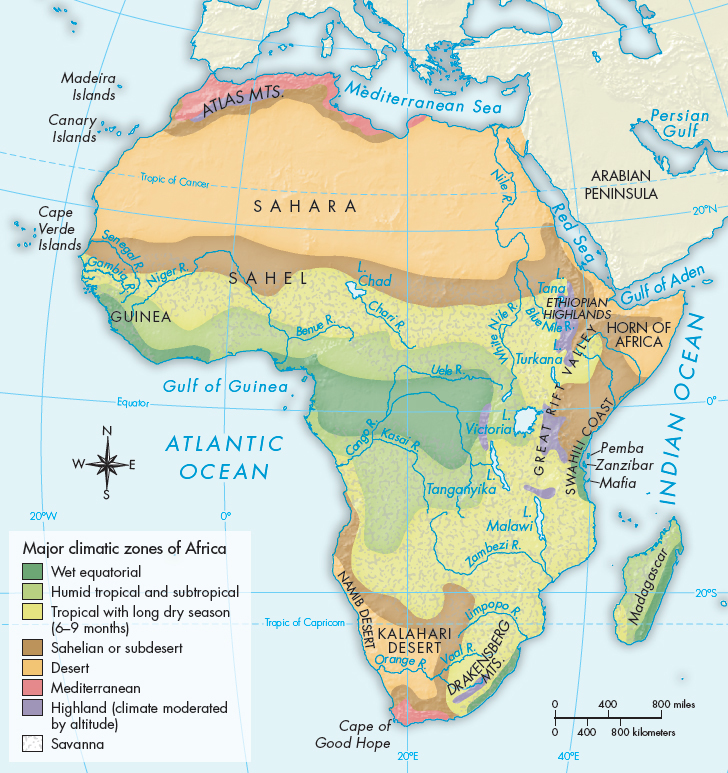A History of World Societies:
Printed Page 268
A History of World Societies Value
Edition: Printed Page 267
Chapter Chronology
The Land and Peoples of Africa
How did Africa’s geography shape its history and contribute to its diverse population?
The world’s second-largest continent after Asia, Africa covers 20 percent of the earth’s land surface, and cultures are enormously diverse both within and across regions. It is difficult and mistaken to make broad generalizations about African life — statements that begin “African culture is . . .” or “African people are . . .” are virtually meaningless. African peoples are not and never have been homogeneous, and this rich diversity makes the study of African history exciting and challenging.
Five main climatic zones roughly divide the African continent (Map 10.1). Fertile land with unpredictable rainfall borders parts of the Mediterranean in the north and the southwestern coast of the Cape of Good Hope in the south. Inland from these areas are dry steppes with little plant life. These steppes gradually give way to Africa’s great deserts: the Sahara in the north and the Namib (NAH-mihb) and Kalahari in the south. The vast Sahara — 3.5 million square miles — takes its name from the Arabic word for “tan,” the color of the desert. (Folk etymology ascribes the word Sahara to an ancient Arabic word that sounds like a parched man’s gasp for water.) The Sahara’s southern sub-desert fringe is called the Sahel (SA-hihl), from the Arabic word for “shore.” The savannas — flat grasslands — extend in a swath across the continent’s widest part — parts of south-central Africa and along the eastern coast. These savannas are among the richest habitats in the world and account for some 55 percent of the African continent. Dense, humid tropical rain forests stretch along coastal West Africa and on both sides of the equator in central Africa. Africa’s climate is mostly tropical, with subtropical climates limited to the northern and southern coasts and the regions of high elevation. Rainfall is seasonal on most of the continent and is very sparse in desert and semidesert areas.

MAP 10.1 The Geography of Africa Africa’s climate zones have always played a critical role in the history of the continent and its peoples. These zones mirror each other north and south of the equator: tropical forest, savanna, sub-desert, desert, and Mediterranean climate.
Geography and climate have significantly shaped African economic development. In the eastern African plains, the earliest humans hunted wild animals. The drier steppe regions favored herding. Wetter savanna regions, like the Nile Valley, encouraged grain-based agriculture. Tropical forests favored hunting and gathering and, later, root-based agriculture — crops such as yams, potatoes, and cassava, which are high in carbohydrates. Rivers and lakes supported economies based on fishing.

Nok Woman Hundreds of terra-cotta sculptures such as the head of this woman survive from the Nok culture, which originated in the central plateau of northern Nigeria in the first millenniumB.C.E. (Werner Forman/Art Resource, NY)
Africa’s peoples are as diverse as the continent’s topography. In North Africa contacts with Asian and European civilizations date back to the ancient Phoenicians, Greeks, and Romans (see Chapters 5 and 6). Groups living on the coast or along trade routes had the greatest degree of contact with outside groups. The Berbers of North Africa, living along the Mediterranean, intermingled with many different peoples — with Muslim Arabs, who first conquered North Africa in the seventh and eighth centuries C.E. (see “Islam’s Spread Beyond Arabia” in Chapter 9); with Spanish Muslims and Jews, many of whom settled in North Africa after their expulsion from Spain in 1492 (see “Spain” in Chapter 15); and with sub-Saharan peoples, with whom they traded across the Sahara Desert. The Swahili peoples along the East African coast developed a maritime civilization and had rich commercial contacts with southern Arabia, the Persian Gulf, India, China, and the Malay Archipelago.
The ancient Greeks called the peoples who lived south of the Sahara Ethiopians, which means “people with burnt faces.” The Berbers also described this region based on its inhabitants, coining the term Akal-n-Iquinawen, which survives today as Guinea. The Arabs used the term Bilad al-Sudan, which survives as Sudan. The Berber and Arab terms both mean “land of the blacks.” Short-statured peoples, sometimes inaccurately referred to as Pygmies, inhabited the equatorial rain forests. South of those forests, in the continent’s southern third, lived the Khoisan (KOI-sahn), people who were primarily hunters but also had domesticated livestock.
Ancient Egypt, at the crossroads of three continents, was a melting pot of different cultures and peoples. Many diverse peoples contributed to the great achievements of Egyptian culture. Many scholars believe that Africans originating in the sub-Sahara resided in ancient Egypt, primarily in Upper Egypt (south of what is now Cairo), but that other ethnic groups constituted the majority of the population.

